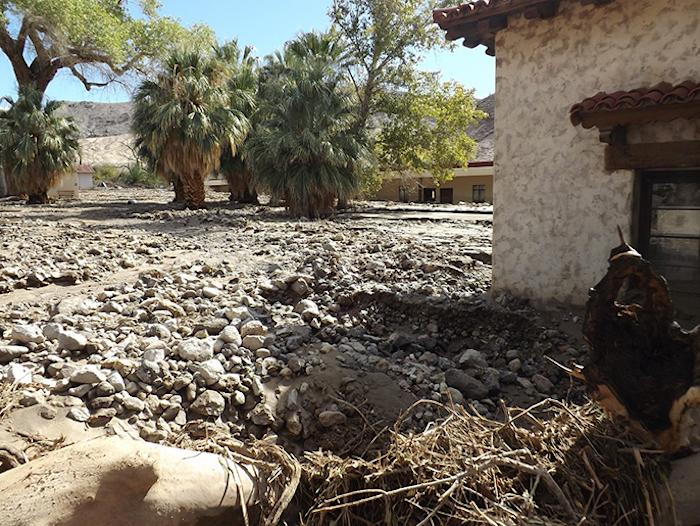
Potent rain storms damaged roads in many areas of Death Valley National Park last week/NPS
Death Valley National Park often is regaled as the "hottest, driest, lowest" place in the hemisphere, but recent rain storms washed away portions of roads, damaged historic Scotty's Castle, and piled debris up 15 feet in places.
While the long-range outcome might be a bounty of wildflowers painting the park come spring, for now crews are working on cleanup and repairs.
"The flash flood through the Scotty's Castle area was a catastrophic event. We were in sprint mode the first 24 hours while evacuating visitors trapped by flooding. Now park staff need to transition into marathon mode. We're gearing up for a long, hard recovery," said Death Valley Superintendent Mike Reynolds.
An engineering report described this flood as the "probable maximum" flood event for Grapevine Canyon, the canyon in which Scotty's Castle is located. Flood waters deposited debris 15 feet above ground in places. A park ranger observed dumpsters floating out of Grapevine Canyon Sunday night. No one was in Grapevine Canyon during the flood. Concrete k-rails, buried to stabilize roads, were blown out by the flood and moved down the canyon.
On the grounds of Scotty's Castle, the historic Garage/Longshed building, which today serves as the castle's visitor center, was heavily damaged, park staff said.
A wall on the south side of the building was broken by the force of the flood and pushed a foot off the foundation. The flood came from the east and the east wall of the building is buried in about 5 feet of mud, making assessment of that wall impossible. Flood waters flowed through the west side of the building, leaving 1-2 feet of mud and debris inside the building.
"The historic Garage/Longshed is severely damaged," Superintendent Reynolds said. "It's not clear yet how much of the building can be salvaged."
Elsewhere in the park, the series of storms that pounded the park last week tore up sections of pavement along the Badwater Road, carved gulches through Artists Drive, and recharged the normally-dry Armagosa River, which was "flowing into southern Death Valley and across Harry Wade Road and West Side Road," park staff reported.
Also sustaining damage was Devils Hole, an unusual warm spring that is the only natural habitat of the endangered Devils Hole pupfish. Park officials said it "had large amounts of mud and rocks washed into it on Sunday morning. There were 131 pupfish counted in September 2015. No population count has been done since the storm washed rocks, mud and clay into Devils Hole, but healthy-looking fish have been seen swimming and spawning."

Scotty's Castle in Grapevine Canyon was particularly hard-hit by the storms/NPS











Comments
Wow.
I was lucky enough to visit Scottys Castle last Saturday, Oct 24 (escorted by Park Service employees as part of a media tour; the site is closed to the general public). The scale of damage is hard to visualize from photos or videos. While the Castle itself sustained only minor damage, all of the infrastructure (water system, sewage treatment, roads, electrical) was almost totally wiped out, and damage to other buildings was extensive (as described inthe article and photos). All in all a very sad day for Scottys Castle, and a reminder that mother nature rules. Superintendent Reynolds can use all the support he can get.
I also was able to visit Devils Hole on Sunday, Oct 25. The water had cleared up, but there was still evidence of the rubble that had washed into the hole. Here's hoping that the pupfish are better adapted to such events than our puny human undertakings.
Why would a "journalist" post as Anonymous? (See above.)
As a journalist myself, that's very odd.
It's a quirk of the system. We're trying to cure it.
Mike Reynolds was the superintendent for National Park of American Samoa when it was hit by the 2009 tsunami. and was a good steady hand through the recovery process. I would expect similar work here.
A natural event that will shape the park and make for more interest this next year. As for the pupfish, if this does anything - it is naturally occuring and should be allowed to happen.
Holy Mackerel!